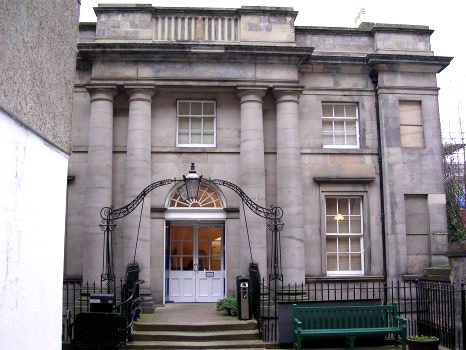
plaquepics2a. Photograph and potted history of the building which used to be the Edinburgh Wax Museum and home of 'Castle Dracula'.

|
The building which was the Edinburgh Wax Museum and home of 'Castle Dracula'. The photo above, taken in 2003, shows two thirds of the frontage which is still exactly how the building looked when used to house the Wax Museum. It was built in 1766 as The New Assemblies Hall. The building, including the fine Georgian sandstone facade by Gillespie Grahame, was restored under the direction of Edinburgh architect John C. Hope, RIBA, to house the Edinburgh wax Museum. Built originally for the dancing assemblies that were in vogue during the eighteenth century, this fine building has been used as a bank and as a children's home (during the conversion over 40 pairs of small wellie boots were found neatly ranged in a cupboard). earlier the building was a Masonic Lodge and Sir Walter Scott himself was a guest at Lodge Meetings. The Assemblies Hall is approached, like many Edinburgh buildings, through a close. These narrow passages, so characteristic of Edinburgh, are variously known as 'close', 'pend' and 'wynd'. A close, it is generally agreed, approaches a private building, a wynd connects public thoroughfares. The precise meaning of pend seems obscure, and visitors are likely to be given widely ranging interpretations of the word. The Assemblies Hall Close leads into the sunny courtyard which fronts the Museum and this space was used for outdoor functions during the summer. |